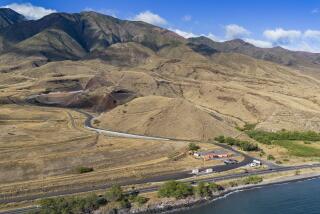ENVIRONMENT / TARGET OR TREASURE? : Hawaiians Fight for Control of Island : Military claimed Kahoolawe for bombing practice. Natives call it a ‘spiritual center.’
- Share via
HONOLULU — When Noa Emmett Aluli looks at the dusty, windblown island of Kahoolawe, he sees a cultural treasure. Ancient petroglyphs etched on its flanks tell of his people’s past.
When the U.S. military trains its sights on Kahoolawe, it sees a target. To the soldiers and sailors who bomb and assault its shores, the uninhabited island offers a chance to practice war as it is really fought.
For more than a decade, Aluli has clung to the dream of stopping the bombing and returning Kahoolawe (pronounced Kah-ho-oh-lah-vey) to Hawaii’s people. In 1976, he and a band of friends took matters in their own hands, sailing across the choppy channel from Maui to land on a rocky beach. The Navy promptly arrested them for trespassing. But the protesters kept coming, even after two were lost at sea.
Today Aluli’s dream is closer than ever to reality. The National Security Council, at the behest of President Bush, is assessing the feasibility of ending use of Kahoolawe as a target. The Navy took over the island during World War II.
“The fact that we have the attention of the White House for the first time in our efforts to stop the bombing is really a breakthrough,” said Davianna McGregor, a spokesman for Protect Kahoolawe Ohana, a nonprofit group. “Ohana” means “family” in Hawaiian.
At first blush, the 45-square-mile island seems unlikely to provoke such an emotional tug of war. Kahoolawe’s battered red dirt swells and cracks in the sun. Scrubby mesquite trees provide scant shade. Goats have stripped its once-productive ranch land, and erosion has slashed steep ravines in its sides.
But the smallest of the state’s eight major islands has become a powerful symbol for Hawaiians. What it lacks in foliage, Kahoolawe makes up for in history. Ancient fishing shrines stud the coastline. At its summit, early Hawaiians studied astronomy and navigation. The entire island is listed on the National Register of Historic Places, so rich is it in archeological features.
“It is a spiritual center that takes us back to our kupuna (elders),” said McGregor. “It has helped the Hawaiian movement find its soul.”
Once dismissed as a radical cause, the push to reclaim Kahoolawe has gradually moved into Hawaii’s mainstream. When the early occupations proved fruitless, Aluli sued the secretary of the Navy on environmental, historic and religious grounds. The court decision was a milestone for the Ohana.
A 1980 consent decree gives Hawaiians access to the island 10 times a year for religious and educational purposes. It limits the shelling to the central third of the island, and requires the Navy to preserve historic sites, stem soil erosion and help revegetate the island.
Over time, one political leader after another has joined the cause, some with dramatic flourish. A few years ago, Maui Mayor Hannibal Tavares planted a flag on the island to claim it for his jurisdiction, while a helicopter overhead scattered thousands of carnations.
Under its visitation rights, the group has brought about 4,000 people to the island. They arrive by boat and wade ashore through the surf, carrying supplies.
While on the island, the group reverts to traditional ways. Ohana members have built a house of wood and thatch that was brought to the island piece by piece. They dive for fish and conduct religious ceremonies, offering leaf-wrapped gifts of food to Hawaiian gods.
Navy personnel always hover nearby, keeping an eye out for unexploded shells that often protrude from the ground. Troops conduct regular ordnance sweeps, but more keeps turning up.
While the bombing has been a public relations disaster for the military, the Navy is proud of its record in reforestation and protecting archeological sites. Officials say they can’t give the island up, however, because it offers a combination of rough terrain and ocean for which there is no alternative.
“There just aren’t other places in Hawaii we can do this type of training,” said Capt. Gerald Mittendorff, Kahoolawe project officer for the Navy. All four branches of the military use the island, operating out of a base camp overlooking its best sandy beach. Every other year, they invite Pacific allies to join them for exercises. Aware of the controversy, Japan and Australia have declined to participate recently, but Canada and South Korea still do.
More to Read
Sign up for Essential California
The most important California stories and recommendations in your inbox every morning.
You may occasionally receive promotional content from the Los Angeles Times.










